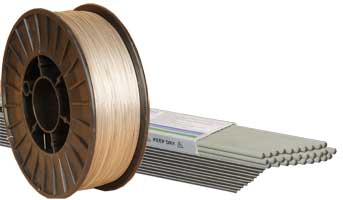01908 6998020845 899 4400 | 01908 699802Tel 01908 699802
Welding Stainless Steel


Welding Stainless Steel is no big deal. As long as you use a suitable welding rod or wire for the type of Stainless Steel you intend welding, all should be pretty straight forward.
Welding Stainless Steel is not vastly different to welding Mild Steel, which is why I say it’s no big deal, however, there are a couple of things worth noting.
- Stainless Steel doesn’t conduct heat as quickly as Mild Steel, so you normally need a little less power.
- Stainless Steel is more prone to distortion.
Types of Stainless Steel
I could write a book on all the different types of Stainless Steel, but for the purposes of this article I’ll stick with just the main two Austinetic Stainless Steels that most of us are likely to encounter.
- 304/304L – This is the most common “general purpose” Stainless Steel and is welded with one of the 308 spec Welding Rods or Wires.
- 316/316L – This grade is most commonly found in food related applications, industrial kitchen equipment for example and is welded with one of the 316 spec Welding Rods or Wires.
Types of Welding Rod or Wire

The general rule with Welding Stainless Steel is to weld it with either the same grade of Welding Rod, Tig Wire or Mig Wire, or a higher grade. So you could weld 304 Stainless Steel with a 308 or 316 Rod/Wire, but you shouldn’t weld 316 with a 308 Rod/Wire.
308 and 316 grades of Welding Rod/Wire are often modified from the basic alloy. These modifications are indicated in the basic spec number, for example, the most common is 308L & 316L, the “L” denotes Low Carbon. A lot of Mig and Tig Wire may be 308LSi & 316LSi, this denotes Low Carbon and added Silicon. Adding Silicon will make the molten weld metal slightly more fluid and so flow better.
Processes for Welding Stainless Steel
Stainless Steel can be welded with a Tig Welder, Mig Welder, or Stick Welder so lets look at the pros & cons of each.
- Tig Welding – This is the slowest process for welding Stainless steel, however, in the right hands, it will produce the nicest looking welds and because of its superior control, distortion can be better mitigated. Stainless Steel is Tig Welded with a Direct Current (DC) output.
Pro = Control/Quality
Con = Slow - Mig Welding – This is the fastest and, arguably, the easiest process for welding Stainless Steel and is ideal for production environments. Welds are unlikely to be works of art, but if that’s not important, Mig is a good option for most operators.
Pro = Fast and no harder than Mig Welding Mild Steel, no machine modification is needed, just a reel of Stainless Steel Wire and Argon/Co2 Gas.
Con = Not good for decorative welds. Limited control of distortion. - Stick Welding – welding Stainless Steel with a stick welder is as straightforward as Mild Steel; if anything, slightly easier, as the rods tend to run with a nice soft, smooth arc. Only thing to watch out for is the slag! This tends to fly off on its own and has a nasty habit of getting in your eyes. This is VERY painful (I speak from bitter experience 🙂 keep an auto helmet down, or wear safety glasses until ALL slag is removed.
Pro = No harder than stick welding Mild Steel
Con = Not as good as Tig for decorative welds and potentially dangerous slag removal.
I hope you found this useful, if things work out well for you, please feel free to post some pictures of your achievements on our Facebook Page
Please let me know what you thought of this article by leaving a comment. Don’t worry, your email address won’t be added to a database or shared and you won’t receive any unsolicited email.
Cheers
Graham


Merci Graham, votre blog me va droit, je cherchait à comprendre quelque chose que vôtre blog m’a éclair, hors j’avais souder l’inox 316L avec la Basique (7018), tout en me bassant sur la résistance et sur l’inconvénient alimentaire. Selon vous quel est le grave erreur ?
Hi Koumba
I have translated your message to English with Google Translate, so I hope I’ve been able to understand your message correctly!
Welding 316 Stainless Steel with 7018 Carbon Steel electrodes is a problem! Especially if the 316 Stainless Steel is being used in a food environment. If this is the case, you will need to grind out the 7018 weld deposit and re-weld with a 316 welding rod.
Regards Graham
hi mr graham.
i have one question if the welder is qualified in ss 304 base metal is he qualified to weld 316 base material?as per asme 9 procedure?
Hi Giero
I regret I don’t know the answer to that, but I suspect he would not be qualified as 304 is a lower grade Stainless Steel than 316! I suggest you check with the organisation that qualified your your welder as they should know for sure.
Sorry I couldn’t help any further.
Regards Graham
I’d like to know if I can use Er316L to weld both 316L and 347? in the ASME Section 9 they both grouped under the same P.number as well as the group. I just got confused. Can you clarify this? 🙂
Hi Adda
The “General Rule” with 300 series Stainless Steels is to weld with the same grade, or higher. So NO, I wouldn’t weld 347 with a 316 filler material. I guess a lot depends on the application, but if you’re being paid to do a job for someone, I wouldn’t want to risk comebacks for the sake of getting the correct welding Filler product!
Hope that helps, at least a bit 🙂
Cheers Graham
I submitted a proposal for welding of A312 TP304L, TP316 and TP316L with ER316L. Now the Client is asking expalnation.
The pipes are impact tested at room temperature. And the application of 316L is 1 inch diameter pipe with 3.38 mm wall thickness. And around 3 meters length in total.piping
So please share your technical justification with code/standard evidence. whether I use ER316L for all grades or shall I propose with ER 308L, ER316 and ER316L.
Thanks in advance
304 and 316 Stainless Steels can both be welded with 316 filler wire.
Cheers Graham
Hi Graham,
Thanks for your very informative blog.
I have a much loved 316 stainless steel stove top kettle with 2 pinholes in the base from being left on a live gas ring. Would Silver Solder of Mig welding be the best process for an amature in both processes?
Thanks again
Hi Des
If the metal is not too thin, I would opt for Mig. Silver Soldering Holes has a few challenges, as does Silver Soldering Stainless Steel. If the metal is very thin, consider taking the kettle to a pro for Tig Welding, will cost more, but would be safest option to keep the much loved kettle going.
Hope that helps
Cheers Graham
Is stick welding stainless more prone to cracking from heat stress then other processes.
I’m welding stainless firplace.
I’m proficient in all possesses
Hi Steve, not in my experience (assuming it’s a regular Stainless Steel, 304 or 316 for example). Stick welding may be more prone to distortion than Tig Welding because the weld build up tend to be bigger, so more shrinkage occurs. Tig would allow you to better control the size of build up to minimise distortion.
If you are using a more specialised Stainless Steel, it would be wise to look up the recommended welding procedure before welding.
Hope that helps,
Cheers Graham
Good day sir!we would like to inquire regarding the possible use of 308 stainless welding rod in replacement of 316 stainless welding for use of palm rudder strut post of ship/vessel.Based on the palm rudder nameplate,316 was indicated to be used.pls let us know.thanks
Hi Jhoel
I would not recommend using a 308 welding rod where a 316 is recommended by the manufacturer of the part to be welded.
With 300 series Stainless Steels, you should always weld a part with a rod that is the same grade, or higher.
So you could weld a 304 stainless steel part with a 316 welding rod, but you should NOT weld a 316 part with a 308 welding rod as 308 is a lower grade!
Hope that helps
Regards Graham
Will welds crack if 308 stainless filler rod is used to weld 316 stainless material?
Hi Ryan
No, the welds won’t crack, but you should always weld a 300 series Stainless with the same, or a higher grade filler wire/rod!
So welding 304/308 stainless with 316 filler is no problem. But if you weld 316 with 308 filler, the properties of the weld metal will be lower than the properties of the job.
316 is Food Grade Stainless Steel, so you should not use 308 filler if the job is going into a food environment.
Hope that helps
Cheers Graham
I would like to weld a few different sized campfire grates in my home garage for hiking and camping. I did some welding in high school. I’m guessing a stick welder would be most practical for a first home welder. Would you agree? I’m guessing 308L or 316L based on your article. Would you agree? Any suggestions?
Thanks!
Derrick
Hi Derrick
An Arc Welder or Mig Welder would be ideal. You will need Rods/Wire that at least matches the grade of Stainless you’ll be using. If food is going to be coming into contact with the grates, you’ll need to use 316 material and 316 rods/wire, if no food contact, 304 material and 308 rods/wire will be fine.
Hope I’ve helped, cheers Graham
Very informative… may God bless you
Thanks for the kind and thoughtful comments, sorry I haven’t been able to respond sooner.
Regards Graham
Very helpful. Statight forward especially for a starter like myself. Thanks Graham.
Hi Benjamin
Thanks for the kind and generous comments, sorry I haven’t been able to respond sooner.
Regards Graham
thank you for the information, I do have a question tho, would a typical stick welder with 225 Amps be big enough to weld a exhaust hood in a concession trailer, it is made of 18ga stainless
Hi Adrian
Sorry I’ve not been able to reply earlier. I’m guessing it’s too late now, but 225amps should be loads of power for 18g Stainless.
Regards Graham
Top content here – easy, informative, answers questions before I need to ask them. Thanks!
Thanks for the comment Matt, much appreciated.
Glad you’ve found my ramblings useful 🙂
Cheers Graham
First time ive stumbled on your site and its so refreshing to get the answer im looking for instantly and clearly you are now bookmarked l.
Thanks.
Thanks for the comment Gordy, much appreciated.
Glad you found the article and our website useful.
Cheers Graham
So glad I found this site. Looking to have stainless steel bar drilled and a high tensile bolt inserted then welded together.
Thought about sourcing somebody to tig weld but now, I hope somebody could mig them so long as s/s wire and argon used.
Thanks for your pleasant and informative site.
Thanks for the comment, glad you fund the article and our website useful.
Kind Regards, Graham
Thanks Graham for your easy, to the point explanation. I was looking out for options to weld ss316 bare cable 240sq. mm to be run underground for straight & T types.This explanation will help me to choose.
Hi Abhijit
Thanks for the comment, glad you found the article useful.
Cheers
Graham
As usual graham your bogs are straight to the point , not complicated , easy to follow and very helpfull.
Thankyou.
Regards dell
Thanks Dell, much appreciated.